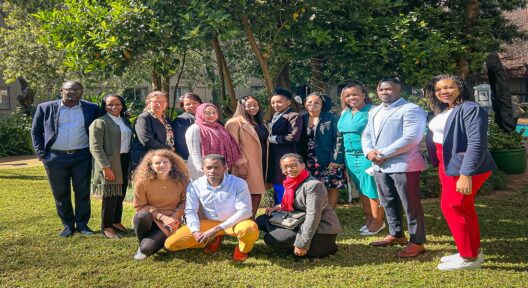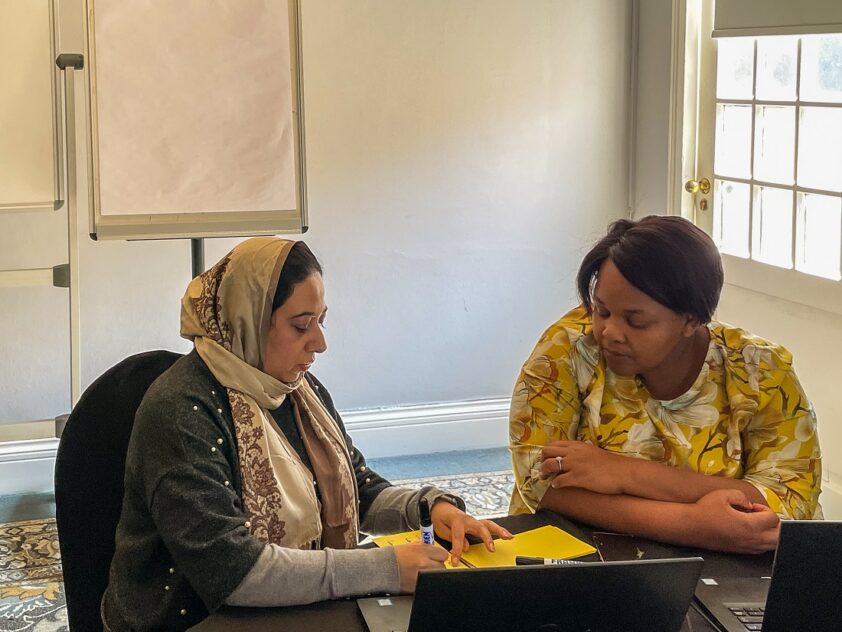Finalisation of the Regional Framework for Accelerated Approvals of Medicinal Products during Public Health Emergencies
August 2022 – „Two days like magic“ perfectly summarises the atmosphere of mutual respect and support among the CoronaGlobal Technical Working Group (TWG) during the CoronaGlobal Phase 1 Close-out workshop in South Africa. For the first time, the TWG could meet in person for an onsite workshop in Johannesburg after one year of solely virtual meetings. This event marks both the ending of the Project Phase 1 and the beginning of the Project Phase 2 of the CoronaGlobal Project. The group’s strong commitment fuelled by the fact-to-face conversations made this a successful event.

Onsite Workshop
The two-day workshop was the highlight of the one-year collaboration between the TWG comprising eleven national medicines regulatory authorities (NMRAs) of the Southern African Development Community (SADC) region and the PharmTrain-CoronaGlobal team. The major goal of the meeting was the completion of the regional framework for an Emergency Use Authorisation (EUA) in the SADC region, the so-called SADC-EUA-F. This step represents the end of the first project phase.
The framework, which is based on the World Health Organization’s Emergency Use Listing Procedure (EUL)1, plays an important role in strengthening structures of NMRAs. It is a tool for closing gaps in regulatory emergency preparedness and thus improving response to public health emergencies. Furthermore, this framework fosters harmonisation and promotes work-sharing in Southern Africa. When domesticated and nationally implemented, the resulting guidelines on Emergency Use Authorisation will serve for accelerating the assessment of drug candidates during emergencies. The latter steps delineate Phase 2 of the CoronaGlobal project.
Fakten

Sakhile Dube-Mwedzi, a regulatory consultant in SADC Medicines Regulatory Harmonisation Programme, opened the workshop with the words
The next two days are like magic.
to cherish the long-awaited chance of meeting in person and being able to work face-to-face together. The positive spirit, the group members’ enthusiasm and openness during the workshop underpinned the achievements of the past year, one of which is the mutual trust that had been built both among the colleagues from SADC region and with the PharmTrain team.
Close-out project phase 1: The regional framework – SADC-EUA-F
Before the participants got down to business, a short warm-up exercise was done to get to know each other even better and to nurture a good working relationship. A plenary discussion was held on the definitions used in the framework. This part of the workshop resulted in an intensive discussion and revealed the complexity of harmonisation. The disagreements arose over a different use of terminology depending on each NMRA. In the end, the working group consolidated for greater harmonisation by agreeing on a consistent terminology in the SADC-EUA-F. This was also pointed out by a participant’s comment:
(…) It will also ensure a common approach within the region.
The discussions also provided an excellent opportunity for all participants to exchange their ideas as indicated by a group member’s feedback:
I did like most about the workshop the interaction amongst the peers, learning about other NMRAs’ processes, and networking with peers.
During the workshop sessions the participants reviewed the framework critically which led to the conclusion that some aspects of the WHO-EUL framework are not suitable for the EUA process in SADC NMRAs. Therefore, adjustments had been incorporated to reflect regional conditions and circumstances in terms of timelines and a specific work-sharing approach for the regional collaborative medicines assessment initiative called “ZaZiBoNa”. Throughout the entire process, participants exchanged their experiences and learned from peers.
In the end, the TWG agreed on the use of the SADC-EUA-F as a tool to assist regulatory authorities to develop a new EUA guideline or strengthen existing emergency use guidelines. It is meant to serve for domestication and shall be adapted to country-specific needs e.g. by further delineating timelines and procedures. In line with this, a TWG member emphasised:
The framework will be useful to all countries, i.e. those with and without an EUA guideline, as it is quite detailed and explicit in some sections.

Kickoff project phase 2: national implementation as EUA guideline “
The CoronaGlobal Project Phase 2 period started in September 2022 and will last until March 2023. During this period, the overall goal is the development of a national EUA guideline by adaption of the SADC-EUA-F in selected countries of the SADC region. Furthermore, the PharmTrain-CoronaGlobal team will- to the extent possible- also support the implementation process of the EUA guidelines in these countries. For the Project Phase 2, a number of countries of the SADC region have expressed their interest. Therefore, a survey based on the Global Benchmarking Tool of the World Health Organisation was established and conducted prior to the workshop.
During the brainstorming session concerning the Project Phase 2, ideas of all TWG members, including applicants and non-applicants of the Project Phase 2, have been gathered. The discussed topics were related to (1) the required adaptations to the framework for developing a country-specific EUA guideline, (2) the goals and expectations of the NMRAs, (3) the role of the PharmTrain-CoronaGlobal team, and (4) any other thoughts and ideas.
The results of this process served as a foundation of the Project Phase 2 to understand the needs of each NMRA and the individual support required by NMRAs. Non-applicants expressed the wish to undertake the role of observers during the second phase to learn from the experience of active participants with regards to steps required for adapting and implementing a national EUA guideline. After ending the Project Phase 2, the shared knowledge could be used for future collaborations among SADC NMRAs e.g. in a Twinning Partnership Model for national EUA guideline implementations in other SADC countries.
The workshop validated the importance of a face-to-face approach.
This feedback was obtained by a participant in the anonymous survey issued by the project team at the end of the workshop.

The vast majority highlighted the opportunity of a personal meeting and being able to work onsite. In summary, the workshop provided an ideal platform for networking amongst NMRAs in the SADC region and fostered sharing experience amongst peers. With this positive feedback, the working group is highly motivated and looks forward to the Project Phase 2 when the regional framework will be translated into national guidelines.
First and foremost, the onsite workshop speeded up the work progress and led to the finalisation of the regional framework. Without a doubt, this success would not have been possible by simply continuing the work online.
The completion of this framework contributes to an enhanced emergency preparedness in the SADC-region and promotes harmonisation and reliance.
1 World Health Organization. Emergency Use Listing Procedure. World Health Organization; 2022.
Date: November 2022


